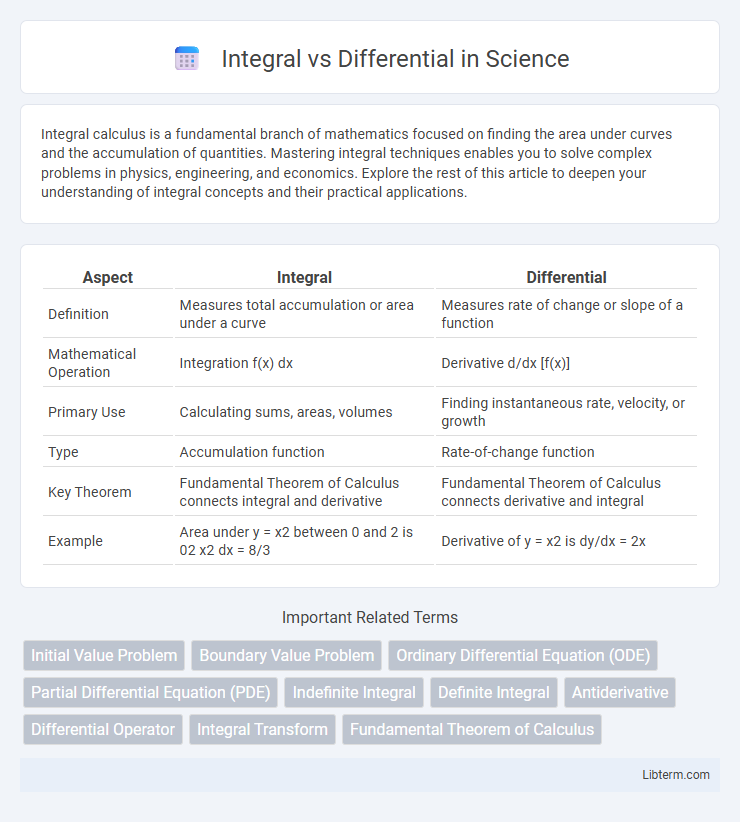Integral calculus is a fundamental branch of mathematics focused on finding the area under curves and the accumulation of quantities. Mastering integral techniques enables you to solve complex problems in physics, engineering, and economics. Explore the rest of this article to deepen your understanding of integral concepts and their practical applications.
Table of Comparison
| Aspect | Integral | Differential |
|---|---|---|
| Definition | Measures total accumulation or area under a curve | Measures rate of change or slope of a function |
| Mathematical Operation | Integration f(x) dx | Derivative d/dx [f(x)] |
| Primary Use | Calculating sums, areas, volumes | Finding instantaneous rate, velocity, or growth |
| Type | Accumulation function | Rate-of-change function |
| Key Theorem | Fundamental Theorem of Calculus connects integral and derivative | Fundamental Theorem of Calculus connects derivative and integral |
| Example | Area under y = x2 between 0 and 2 is 02 x2 dx = 8/3 | Derivative of y = x2 is dy/dx = 2x |
Introduction to Integral and Differential Calculus
Integral calculus deals with the accumulation of quantities and the areas under curves, focusing on finding integrals that represent sums or total values. Differential calculus examines the rate at which quantities change, using derivatives to analyze instantaneous rates of change and slopes of curves. Both branches form the core of calculus, providing tools for modeling and solving problems involving change and accumulation in mathematics, physics, and engineering.
Definition of Integral Calculus
Integral calculus is the branch of mathematics that deals with the accumulation of quantities, such as areas under curves, total distances, and volumes, by finding integrals. It involves the concept of an integral, which represents the sum of infinitesimally small parts to determine the whole. Unlike differential calculus, which focuses on rates of change and slopes of curves, integral calculus emphasizes the aggregation and accumulation of data over intervals.
Definition of Differential Calculus
Differential calculus is the branch of calculus that studies the rates at which quantities change by analyzing derivatives and slopes of curves. It focuses on finding the instantaneous rate of change of a function with respect to its variables, enabling precise modeling of dynamic systems. Integral calculus, by contrast, deals with the accumulation of quantities and the calculation of areas under curves, representing the inverse process of differentiation.
Core Concepts: Integration vs Differentiation
Integration calculates the accumulation of quantities, representing the area under a curve or total change over an interval, often expressed as the integral of a function. Differentiation determines the rate of change or slope of a function at a specific point, defined as the derivative that measures how a function value changes with respect to its input. Both processes are fundamental in calculus, with the Fundamental Theorem of Calculus establishing their inverse relationship.
Mathematical Notations and Symbols
Integral notation primarily uses the elongated S symbol () to represent the summation of infinitesimal quantities, coupled with a function f(x), the differential element dx, and limits of integration a and b when definite. Differential notation emphasizes the derivative operator d/dx or prime notation f'(x), symbolizing instantaneous rates of change, often represented as dy/dx, where y is dependent on x. Both notations form the cornerstone of calculus, with integrals aggregating area or accumulation, and differentials expressing local variation, each with distinct symbolic conventions crucial for precise mathematical communication.
Fundamental Theorems Linking Integration and Differentiation
The Fundamental Theorem of Calculus bridges integration and differentiation by stating that differentiation is the inverse process of integration, establishing a direct link between the two operations. The first part of the theorem asserts that the integral of a function's derivative over an interval recovers the function's net change, while the second part provides a method to evaluate definite integrals using antiderivatives. This connection underpins many applications in physics and engineering, enabling the transition from rate functions (derivatives) to accumulated quantities (integrals).
Applications of Integral Calculus
Integral calculus plays a crucial role in fields such as physics, engineering, and economics by enabling the calculation of areas under curves, volumes of solids, and accumulated quantities. It is extensively used to determine displacement from velocity data, compute work done by variable forces, and model growth processes in natural sciences. Applications also include finding probabilities in statistics, optimizing resource allocation, and solving differential equations that describe real-world phenomena.
Applications of Differential Calculus
Differential calculus plays a critical role in optimizing engineering designs by enabling the calculation of rates of change and slopes of curves, essential for determining maximum efficiency and performance. It is widely used in physics to analyze motion dynamics, allowing precise computation of velocity and acceleration from position functions. In economics, differential calculus helps model cost functions and optimize profit by identifying marginal rates of change in production and consumption.
Key Differences Between Integral and Differential Calculus
Integral calculus focuses on finding the accumulation of quantities and the area under curves, using concepts like definite and indefinite integrals. Differential calculus centers on the rate of change and slope of functions, employing derivatives to analyze instantaneous change. Key differences include their applications: integrals calculate total values from rates, while derivatives determine rates of change from accumulated quantities.
Choosing the Right Approach: When to Use Integral or Differential Calculus
Integral calculus is ideal for finding the total accumulation or area under curves, such as calculating distance from velocity data or total growth over time. Differential calculus excels in analyzing rates of change and instantaneous behavior, like determining speed at a specific moment or optimizing functions. Choosing between integral and differential methods depends on whether the problem involves accumulation or rate analysis.
Integral Infographic

 libterm.com
libterm.com